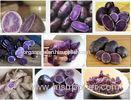
Fresh Organic Sweet Purple Potato With Clean Surface For Mashed Potatoes
| Place of Origin: | Shandong |
|---|
Company Profile
| Location: | Yantai, Shandong, China (Mainland) |
|---|---|
| Business Type: | Manufacturer |
| Main Products: | Organic Fuji Apple |
Product Detail
| Model No.: | P923 |
|---|
Product Description
Fresh Organic Sweet Purple Potato With Clean Surface For Mashed Potatoes
Quick Detail:
Product Type: Potato
Type: Potato
Style: Fresh
Cultivation Type: Common
Shape: Long
Maturity: 100%
Certification: ISO 9001, SGS, HACCP
Size (cm): 10
Weight (kg): 0.15
Place of Origin: Shandong China (Mainland)
Brand Name: Potato
Model Number: P922
Description:
woven bag 50kg potato blue potatoes
1) Our Advantage: we have our own plant for processing Holland potato.
2) Standard: top grade, suitable to exporting to all over the world.
3) Place of Origin: Shandong province, China
4) Features: Good quality, smooth, yellow inside and nature yellow skin.
5) Supplying period:
A. Cold storage season: from August to November.
B. Fresh season in Shandong: from Feb. to April, from May to July, from November to Dec.
6) Sizes:
A. Cold storage potato size in Shandong: 75 - 150g, 100 - 200g, 125 - 200g, 200g and up.
B. Fresh potato size in Shandong: 50 - 100g, 100 - 150g, 150 - 200g, 200g and up.
7) Packing: we can pack according to your requirement by ctn or mesh bag
8) Weight/conveyance:
A.26-31MT/40' reefer container, packing: carton.
B.26-32MT/40' reefer container, packing: mesh bag.
9) Shipment port: Qingdao port, China.
10) Inspection Certificate: Certificate of Origin, Phytosanitary Certificate and Inspection Certificate of Quantity
Nutrition
The potato contains vitamins and minerals, as well as an assortment of phytochemicals, such as carotenoids and natural phenols. Chlorogenic acid constitutes up to 90% of the potato tuber natural phenols. Others found in potatoes are 4-O-caffeoylquinic acid (crypto-chlorogenic acid), 5-O-caffeoylquinic (neo-chlorogenic acid), 3,4-dicaffeoylquinic and 3,5-dicaffeoylquinic acids. A medium-size 150 g (5.3 oz) potato with the skin provides 27 mg of vitamin C (45% of the Daily Value (DV)), 620 mg of potassium (18% of DV), 0.2 mg vitamin B6 (10% of DV) and trace amounts of thiamin, riboflavin, folate, niacin, magnesium, phosphorus, iron, and zinc. The fiber content of a potato with skin (2 g) is equivalent to that of many whole grain breads, pastas, and cereals.
The potato is best known for its carbohydrate content (approximately 26 grams in a medium potato). The predominant form of this carbohydrate is starch. A small but significant portion of this starch is resistant to digestion by enzymes in the stomach and small intestine, and so reaches the large intestine essentially intact. This resistant starch is considered to have similar physiological effects and health benefits as fiber: It provides bulk, offers protection against colon cancer, improves glucose tolerance and insulin sensitivity, lowers plasma cholesterol and triglyceride concentrations, increases satiety, and possibly even reduces fat storage. The amount of resistant starch in potatoes depends much on preparation methods. Cooking and then cooling potatoes significantly increases resistant starch. For example, cooked potato starch contains about 7% resistant starch, which increases to about 13% upon cooling.
The cooking method used can significantly affect the nutrient availability of the potato.
Potatoes are often broadly classified as high on the glycemic index (GI) and so are often excluded from the diets of individuals trying to follow a low-GI diet. In fact, the GI of potatoes can vary considerably depending on type (such as red, russet, white, or Prince Edward), origin (where it was grown), preparation methods (i.e., cooking method, whether it is eaten hot or cold, whether it is mashed or cubed or consumed whole, etc.), and with what it is consumed (i.e., the addition of various high-fat or high-protein toppings).
In the UK, potatoes are not considered by the NHS as counting towards the five portions of fruit and vegetables diet.
|
Nutrient content of major staple foods |
||||||||||
|
STAPLE: |
Maize / Corn[A] |
| ||||||||

